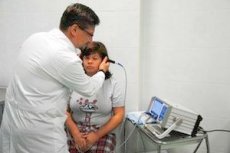
All iLive content is medically reviewed or fact checked to ensure as much factual accuracy as possible.
We have strict sourcing guidelines and only link to reputable media sites, academic research institutions and, whenever possible, medically peer reviewed studies. Note that the numbers in parentheses ([1], [2], etc.) are clickable links to these studies.
If you feel that any of our content is inaccurate, out-of-date, or otherwise questionable, please select it and press Ctrl + Enter.
Ultrasound echoencephalography
Medical expert of the article
Last reviewed: 06.07.2025

Ultrasound echoencephalography (EchoEG) is based on the principle of echolocation.
The purpose of echoencephalography (EchoEG)
The purpose of EchoEG is to identify gross morphological abnormalities in the structure of the brain ( subdural hematomas, cerebral edema, hydrocephalus, large tumors, displacement of midline structures ), as well as intracranial hypertension.
Who to contact?
How is echoencephalography (EchoEG) performed?
The echoencephalograph sends short ultrasound pulses to the brain, which are generated by a special piezoelectric emitter (a crystal that changes its linear dimensions under the influence of applied high-frequency electrical voltage). They are partially reflected from the boundaries of media and tissues with different acoustic resistance ( the bones of the skull and the membranes of the brain, brain tissue and cerebrospinal fluid in the ventricles of the brain).
To transmit ultrasonic pulses from the emitter to the scalp without reflection, the skin and the surface of the probe (emitter-sensor) are covered with a layer of conductive liquid (petroleum jelly or a special gel).
The signals reflected from the brain structures are captured by a special sensor, and their intensity and time delay relative to the moment of the locating pulse output are analyzed by electronic devices and displayed on the monitor in the form of an echoencephalogram. The horizontal scan of the monitor starts at the moment the ultrasound pulse is sent.
The position of the reflected signals on the screen allows us to judge the relative position of the brain structures.
There are three main signal complexes on the echoencephalogram. The initial and final complexes are the reflection of ultrasound pulses from the skin and bones of the skull on the side where the probe is located and on the opposite side of the head, respectively. In these same complexes, one can distinguish low-amplitude signals reflected from the boundaries between the gray and white matter of the brain. The high-amplitude midline complex (the "M-echo" signal) when the probe is placed on the temporal region corresponds to the reflection of ultrasound pulses from midline brain structures (the third ventricle, pineal gland, and transparent septum). Normally, the position of the "M-echo" signal should coincide with the so-called "midline of the head", which is determined at the beginning of the study. Echoencephalogram in pathology
The displacement of the midline structures of the patient's brain (a displacement of 2 mm or more is considered diagnostically significant) is determined by the asymmetric shift of the M-echo signal relative to the midline, and the presence of intracranial hypertension is determined by the magnitude of its amplitude pulsation (more than 30-50%).
The presence of cerebral edema, subdural hematomas, large tumors, or ventricular dilation is determined by the appearance of additional signals and is clarified by shifting the position of the sensor.
Alternative methods
The EchoEG method was previously used very widely due to the simplicity of its implementation and interpretation of results, low cost of equipment, and the practical absence of contraindications. Currently, it is increasingly being replaced by more informative neurovisualizing diagnostic methods.


 [
[